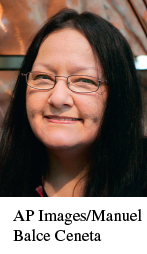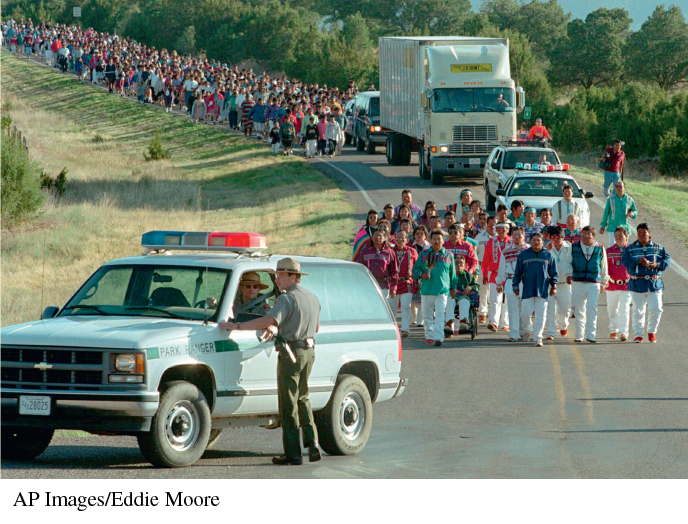Suzan Shown Harjo, “Last Rites for Indian Dead”
Instructor's Notes
To assign the questions that follow this reading, click “Browse More Resources for this Unit,” or go to the Resources panel. To assign a comprehension quiz on this reading, do the same.
|
Suzan Shown Harjo 
AP Images/Manuel Balce Ceneta.
Last Rites for Indian Dead As a result of persuasive efforts such as Suzan Shown Harjo’s essay, the Native American Graves Protection and Repatriation Act was passed in 1990. 1 What if museums, universities, and government agencies could put your dead relatives on display or keep them in boxes to be cut up and otherwise studied? What if you believed that the spirits of the dead could not rest until their human remains were placed in a sacred area? 2 The ordinary American would say there ought to be a law—and there is, for ordinary Americans. The problem for American Indians is that there are too many laws of the kind that make us the archaeological property of the United States and too few of the kind that protect us from such insults. 3 Some of my own Cheyenne relatives’ skulls are in the Smithsonian Institution today, along with those of at least 4,500 other Indian people who were violated in the 1800s by the U.S. Army for an “Indian Crania Study.” It wasn’t enough that these unarmed Cheyenne people were mowed down by the cavalry at the infamous Sand Creek massacre; many were decapitated and their heads shipped to Washington as freight. (The Army Medical Museum’s collection is now in the Smithsonian.) Some had been exhumed° only hours after being buried. Imagine their grieving families’ reaction on finding their loved ones disinterred° and headless. 
Native Americans march with a truck returning 2,000 skeletal remains of Jemez Pueblo Indian ancestors for reburial in New Mexico. The remains had been in the collections of Harvard University.
AP Images/Eddie Moore.
147 4 Some targets of the army’s study were killed in noncombat situations and beheaded immediately. The officer’s account of the decapitation of the Apache chief Mangas Coloradas in 1863 shows the pseudoscientific nature of the exercise.“I weighed the brain and measured the skull,” the good doctor wrote, “and found that while the skull was smaller, the brain was larger than that of Daniel Webster.” 5 These journal accounts exist in excruciating detail, yet missing are any records of overall comparisons, conclusions, or final reports of the army study. Since it is unlike the army not to leave a paper trail, one must wonder about the motive for its collection. 6 The total Indian body count in the Smithsonian collection is more than 19,000, and it is not the largest in the country. It is not inconceivable that the 1.5 million of us living today are outnumbered by our dead stored in museums, educational institutions, federal agencies, state historical societies, and private collections. The Indian people are further dehumanized by being exhibited alongside the mastodons and dinosaurs and other extinct creatures. 7 Where we have buried our dead in peace, more often than not the sites have been desecrated. For more than two hundred years, relic-hunting has been a popular pursuit. Lately, the market in Indian artifacts has brought this abhorrent activity to a fever pitch in some areas. And when scavengers come upon Indian burial sites, everything found becomes fair game, including sacred burial offerings, teeth, and skeletal remains. 148 8 One unusually well-publicized example of Indian grave desecration occurred two years ago in a western Kentucky field known as Slack Farm, the site of an Indian village five centuries ago. Ten men—one with a business card stating “Have Shovel, Will Travel”—paid the landowner $10,000 to lease digging rights between planting seasons. They dug extensively on the forty-acre farm, rummaging through an estimated 650 graves, collecting burial goods, tools, and ceremonial items. Skeletons were strewn about like litter. 9 What motivates people to do something like this? Financial gain is the first answer. Indian relic-collecting has become a multimillion-dollar industry. The price tag on a bead necklace can easily top $1,000; rare pieces fetch tens of thousands. 10 And it is not just collectors of the macabre° who pay for skeletal remains. Scientists say that these deceased Indians are needed for research that someday could benefit the health and welfare of living Indians. But just how many dead Indians must they examine? Nineteen thousand? 11 There is doubt as to whether permanent curation of our dead really benefits Indians. Dr. Emery A. Johnson, former assistant Surgeon General, recently observed, “I am not aware of any current medical diagnostic or treatment procedure that has been derived from research on such skeletal remains. Nor am I aware of any during the thirty-four years that I have been involved in American Indian . . . health care.” 12 Indian remains are still being collected for racial biological studies. While the intentions may be honorable, the ethics of using human remains this way without the full consent of relatives must be questioned. 13 Some relief for Indian people has come on the state level. Almost half of the states, including California, have passed laws protecting Indian burial sites and restricting the sale of Indian bones, burial offerings, and other sacred items. Representative Charles E. Bennett (D-Fla.) and Senator John McCain (R-Ariz.) have introduced bills that are a good start in invoking the federal government’s protection. However, no legislation has attacked the problem head-on by imposing stiff penalties at the marketplace, or by changing laws that make dead Indians the nation’s property. 14 Some universities—notably Stanford, Nebraska, Minnesota, and Seattle—have returned, or agreed to return, Indian human remains; it is fitting that institutions of higher education should lead the way. 15 Congress is now deciding what to do with the government’s extensive collection of Indian human remains and associated funerary objects. The secretary of the Smithsonian, Robert McC. Adams, has been valiantly° attempting to apply modern ethics to yesterday’s excesses. This week, he announced that the Smithsonian would conduct an inventory and return all Indian skeletal remains that could be identified with specific tribes or living kin. 16 149 But there remains a reluctance generally among collectors of Indian remains to take action of a scope that would have a quantitative impact and a healing quality. If they will not act on their own—and it is highly unlikely that they will—then Congress must act. 17 The country must recognize that the bodies of dead American Indian people are not artifacts to be bought and sold as collector’s items. It is not appropriate to store tens of thousands of our ancestors for possible future research. They are our family. They deserve to be returned to their sacred burial grounds and given a chance to rest. 18 The plunder of our people’s graves has gone on too long. Let us rebury our dead and remove this shameful past from America’s future. Questions to Start You Thinking Meaning
Writing Strategies
|
Introduction appeals to readers THESIS taking a stand Point 1 Supporting evidence Question used as transition Transition to concluding proposal Conclusion proposes action |